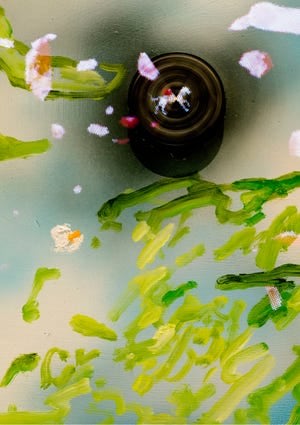
"Pan-Pan", detail, by Rachel Rossin. Megan McCarthy, MEGHAN McCARTHY/The Palm Beach Daily News
Artist sounds the alarm with hologram-embedded art at County Gallery
Jane Moore
Dec. 20, 2021
A vibrant dynamic portal where the physical and virtual worlds merge into colorful conceptual artwork opens an exhibit called “Pan-Pan” at County Gallery in Palm Beach.
The immersive show by New York-based artist Rachel Rossin, designed to be viewed as a singular installation, is based on the concept of escapism and draws from the military’s standard radiotelephony call for help, with “pan-pan” being used just prior to “mayday” — and as such, the title is meant as a reflection of the world’s urgent need for help right now.
The conceptual works, three years in the making, comprise Rossin’s first solo show in this area and the first time she is showing her hologram-combines, which use digitally programmed holographic displays embedded in paintings. The works are an expression of Rossin’s desire to blend the tension between the two worlds that we are being asked to exist in every day by connecting worlds that cannot touch one another but that humans are increasingly spending so much time between.
Even though she began the project before the pandemic, the subject matter has become especially relevant with the onset of lockdowns, social restrictions and the need for even more technology to interact with other humans via such new normals as Zoom meetings, virtual school and online fitness classes.
“When I went to do a studio visit in New York this summer, we were initially planning a singular large installation piece,” said County Gallery director Dalton Freed. “But then she showed me one of the small hologram-combines she had created and I was just blown away. I knew these were the works that would create an amazing show here.”
The colors, lights and abstract beauty of birds and flowers, combined with a soothing color palette are especially well-suited to the idea of Palm Beach as a tropical escape and somewhat different reality than most areas in the country.
Rossin, who was born and raised in West Palm Beach, went to college at Florida State University where she earned a degree in visual art. She has lived in New York since then and was named The New Museum and New Incubator’s first-ever virtual reality research fellow in 2015, where they also commissioned a work from her in 2017. The Whitney also just acquired a work for their permanent collection and has commissioned a joint work with The KW Institute for Contemporary Art in Berlin.
Tiffany Zabludowicz, a prominent collector and curator, has been a supporter of Rossin for many years and includes her work in the prestigious Zabludowicz Collection in London. In her exhibition there called "Stalking the Trace," “Rachel Rossin "literally stopped time as movement could and turned the back room of the collection into a mind-blowing projection-mapped digital vortex of new ideas," Zabludowicz said.
“Every conversation with Rachel gives me a brief glimpse into the future, which she sees so clearly,” Zabludowicz said. “She has been coding since she was 8 years old and is so digitally native that she sees the parameters and potentials of technology before anybody else, the pitfalls and the attractions, and creates pieces that play with that space. She is a visionary artist.”
Rossin's start as an artist began at a young age in her garage, where her great-grandfather, who had worked for IBM in its early days, left behind many machine parts, computers and typewriters, as well as some of the first commercial matrix printers, after he died. Those matrix printers were what Rossin used for some of her first drawings, painting over the matrix dots on the printer paper and creating machine-based drawings.
“Nobody cared about those old computers and printers and parts, but fortunately my mom kept them and stored them all in the garage. It is very similar to what I do now actually, connecting virtual and physical realities with computers and paints," Rossin said.
“I was just left to hang out with these machines in the garage, so and I learned how to work them and just tinker. I started working on Command Line [one of the earliest computer programs] when I was 4, so at the same time I was learning verbal language, I was also working in 'code' language, and then I started computer programming when I was 8 years old. It’s all very similar to how I work now — taking something machine-based and turning it into something very human.”
Regarding her creative process these days, Rossin describes it as more about the feeling of the work and less about the piece itself, and considers herself more of a concept-based vs. media-based artist.
“Usually I start with the background or the physical painting, and then I start animating on top of that,” she says. “So the process, I think, is very similar to the way our lives work. For example, I’m picking up the phone and I’m in real life, but then going into virtual space to communicate to someone. So it’s about tossing the ball between myself in traditional painting and modes like airbrushing, and then working in virtual space with programming, which is what informs the physical space.”
As one of the show’s main narratives of escapism, Rossin has created an environment for this show where one can get away from everything, if at least for a few moments.
“Given the year everyone has had,” Freed said, “Rachel wanted to create an environment where you could get away from everything and experience this wonderful, peaceful, soothing universe, so I thought that was perfect. Everyone needs that right now. The show just made a lot of sense to me for this time we are in.”